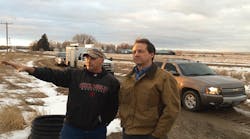Montana Gov. Steve Bullock declared a state of emergency on Jan. 18, following a spill of as many as 50,000 gallons of oil from a 12-inch pipeline operated by the Bridger Pipeline Co. that ruptured about 5 miles upstream from Glendive, Mont., threatening the drinking water of nearby residents. The state’s Department of Environmental Quality, along with EPA and the U.S. Department of Health and Human Services, are on site and helping manage the clean up.
According to recent reports, the oil has spread as far as 60 miles downstream. The Yellowstone River is the longest undammed river in the United States.
Bullock announced a series of initial steps to ensure the health and safety of Montanans, as well as evaluating impacts on Montana wildlife. He has relocated a member of his personal staff to Glendive to ensure the concerns of residents are being addressed. In response to the Centers for Disease Control and Prevention’s suggestion that residents drink bottled water, Bullock instructed the Montana Department of Disaster and Emergency Services to bring in bottled water for residents.
“The health and safety of Montanans in the area impacted by this oil spill is my top concern,” said Bullock. “Local, state and federal officials are working together to quickly assess this situation, and ensure that those responsible are held accountable, the oil is cleaned up and all damages are addressed. My expectation is that the cleanup will continue until it meets the standard of me and the people of Montana.”
Weather conditions and the frozen river are hampering clean up efforts, but workers have dug through the ice and set up booms to try to collect the oil.
In November, the U.S. Department of Transportation's Pipeline and Hazardous Materials Safety Administration sent Bridger Pipeline a warning notice, which stated in part, "Bridger Pipeline staff did not follow their written procedures for conducting normal operations and maintenance activities, specifically your procedures to examine exposed pipe per §195.569. Bridger Pipeline conducted 24 In-line inspection verification digs February 15 -March 20, 2012) on the Poplar Pipeline. All 24 digs were for external anomalies.
"We understand that since none of the coating was removed, the external and internal condition of the pipe's metallic surface were not noted. Nevertheless, the pipe coating was exposed and the condition of the coating and the date of the exposures were not noted on the operator's form PL-502."

